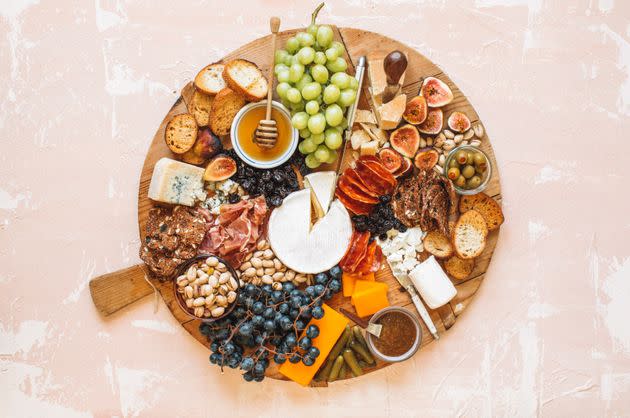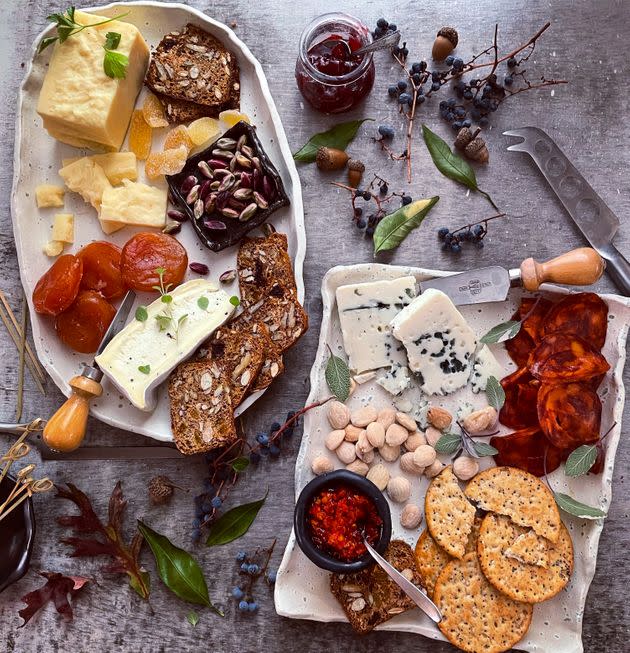How To Make The Best Holiday Charcuterie Board, According To Food Stylists

They’re all over your social media feed – gorgeous charcuterie boards overflowing with seasonal meats, cheeses and crackers. There are even entire winter villages built of these protein-packed appetizers.
If it seems like you’re seeing charcuterie boards everywhere, you’re absolutely right.
“Consumers have excitedly adopted charcuterie, and more than a quarter are creating boards at home at least once per month,” meat industry consultancy Midan Marketing said its research showed earlier this year. “Charcuterie brings foodservice flair for consumers missing in-restaurant dining and provides big, bold international flavors for shoppers who are antsy to travel again.”
Food stylists have some thoughts about what’s powering the meat-and-cheese train.
“Charcuterie boards are both accessible and kind of fancy at the same time,” food stylist, recipe tester and developer Dani McReynolds told HuffPost. “Hosts can put together something beautiful without having to follow a complicated recipe, and it’s pretty much guaranteed that guests will love it. It’s also a snack that allows a choose-your-own-adventure situation for mixing and matching ingredients. I love seeing what people put together.”
What goes on the shopping list?
“For impromptu casual gatherings, I’ve had great success when I’ve thrown together a board with just what I have on hand,” McReynolds said. “But if you want to make a statement board, there’s nothing wrong with a little planning. You could make a Pinterest board for inspo, do some Instagram research and then create a shopping list with everything you need.”
“Plan for at least three varieties of each type of food,” food stylist Ann Belden advised. “A mild salami, a spicy soppressata and maybe a smoky sausage would be a fine combination for meat. With cheese, take the same approach, serving one triple cream or soft ripened one, alongside a hard and a medium variety.”

Commercial food stylist and cookbook author Lisa Golden Schroeder suggested shopping with an eye to contrasts.
“I’m a fan of savory, sweet, salty and briny flavors, and I think it’s fun to play with what can seem like opposing tastes, like drizzling blue cheese with honey or serving quince paste with manchego cheese,” Schroder said. “Cured meats can love interesting condiments like sweet-tangy mustard, caramelized shallots or an herby ketchup made from something other than tomatoes.”
Do I really need to buy the most expensive ingredients?
Not at all, although you might want to splurge on small bites you love. Shopping shouldn’t have to be a multi-stop chore, either.
“You can find ingredients in your own cupboard or refrigerator, as well as at specialty food shops, local grocery stores or even convenience markets,” food stylist Amy Andrews said.
Food stylist Christina Zerkis said people are thrilled with the kinds of things they find at Trader Joe’s, for example. “The important thing is to assemble the items you really want to dig into,” she said.
Be sure that what you do buy is the best quality you can afford, especially for meats and cheeses.
“If the cured meat is processed using cost-saving methods and inferior cuts of meat, the mouthfeel becomes sticky, and the flavor is bland and often acidic,” Evan Inada, charcuterie and partnerships director for Columbus Craft Meats, said. Instead, he suggested seeking out “true artisan salami” for your board. Buying a little less of the truly good stuff might improve your board’s taste.
If you want to limit the spendy items but still make the board seem full, the stylists we talked with suggested filling empty spaces with greenery, fruits and decorations.
“One tip, which caterers use too, is to use decorative kale leaves that won’t wilt,” Schroeder said. “Use them judiciously to line a tray or platter, or to help separate ingredients.”
Some ingredients can even be free.
“I think it’s really nice to forage in your own garden for edible leaves, herbs and branches,” Andrews said.
“Don’t be afraid to be an ‘herbal guerrilla’ if you live somewhere where there are herbs growing on the street,” said Belden, who’s based in San Francisco. “There are four Grecian laurel trees a block from my house that keep my charcuterie boards supplied with bay leaves year-round. Just make sure to wash everything first, and use only edible garnishes.”
How much will my guests eat?
“A good rule of thumb is about two ounces of each type of food per guest,” Belden said. “If the party is a long one, make it five ounces each. But do have extra ingredients on hand in case your guests happen to be big eaters.”
What sort of board do I need?
It turns out that any flat surface can serve as a charcuterie board, and it doesn’t have to be expensive.
“Do yourself a huge favor and go to Home Goods for a good-sized wooden board that you can dedicate to your first charcuterie build session,” Zerkis said. “They’re about $20, and they’re totally worth it. Scrub it clean afterward, and oil it with avocado oil once in a while.”
There are lots of other places to look. “Instead of shopping at kitchen supply stores, you can buy amazing boards at flea markets, Chinatowns and grocery stores,” Belden said. “Keep your eyes open, and look for ones that really appeal to you. You’re likely to have them a long, long time.”
Make sure you right-size your board, too.
“If you buy a huge board for a small party, it will either be very sparse and sad-looking, or you’ll end up buying more than you need to make it look nice,” McReynolds said.

How do I prep my board?
“I always start with a board that’s a clean and sanitized space to hold food,” chefJametta Raspberry, owner ofHouse of Gristle in the Twin Cities, said. “Then I like to cover the bottom with a piece of parchment or Saran Wrap.”
How do I get started?
Step one: “Anchor” cheeses
“Set up a few mounds of leafy greens, like arugula or mixed greens, which hold up well,” Raspberry said. “Then place cheeses up against the greens, making sure each type of cheese is far enough away from one other.”
Step two: Fluffed prosciutto and salami rivers
Now it’s time for meat, if you’re using it. “You don’t want slices to stick together, so arrange them in a way that makes it easy to pick them up with a small serving fork or pick,” Belden said. And here’s a tip you don’t hear every day: “The prosciutto should be fluffed, not flat.”
Inada said that rotating half folds of salami “will create perfect petals for a salami rose.” He added: “Folding salami twice and stacking them on toothpicks creates a fluid salami river, or you may just enjoy the simple beauty of cutting a salami stick with your knife to exactly the thickness you like it.”
Step four: Decorate your board
“Sometimes a board can be a bit beige, so adding some vibrant colors really ups the visual appeal and make people excited to dig in,” McReynolds said.
“My belief is if it grows from the ground, it’s fair game,” Raspberry said. “Since it’s the holiday season, consider adding details such as cinnamon sticks, a wedge of pomegranate, rosemary or even pine cones. Try to avoid things that could break or shatter, such as small ornaments. And if you’re using edible flowers, start with the leaves first, tucking those under other ingredients.”
“I like mandarins with pretty leaves attached,” chef and food stylistKara Mickelson said. “Or opt for small pears, crab apples, persimmons, grapes and pomegranates — whole or split open, showing the jewel-tone seeds. Dried or candied fruits bring a pop of color, and their sweetness balances out salty meats and cheeses.”
Step five: Finishing touches
When food and decorations are in place, add tongs, spoons and knives where needed. Another final touch, Mickelson suggested, is to “use markers to identify items, and add small dishes for anything that has a liquid or sauce.”
“Bamboo toothpicks are lovely to pick up cubed cheeses,” said food stylist, cookbook author and chefAurora Satler. “You’ll also want to set out small plates and cocktail napkins to the side. The easier it is for them to serve themselves, the longer your board will stay looking beautiful as guests graze.”
Finally, keep in mind what will happen when the eating starts in earnest. “Have an empty container for used picks and skewers,” Mickelson said.
Help! This thing is going to spill on my way to the party.
No worries! Just do an on-site setup. Ask your hosts in advance if it’s OK for you to arrive a little early and to take up some counter space for board creation. Then arrive with your board, any tools you need and your bag of ingredients.
All my ingredients are getting pawed through, and my design is ruined.
You may have loaded it up too much. Although a feeling of abundance is the overall concept, “you can have too much on a board,” Satler said.
Overcrowding, many of the stylists said, creates an ingredient pile-up that can make it hard for guests to access what they want.
“The goal is to keep a balance between what’s visually appealing and what’s easy for guests to quickly grab without destroying the artful display,” Mickelson said.
“While huge piles of food may look amazing, I think there should be some practical space left to keep things easier for the taking,” Andrews said.
Raspberry had this tip: “Take a step away from your board from time to time to make sure you’re still seeing the big picture.”
My guests devoured everything, and now the board looks picked over.
There’s a great switcheroo trick that food stylists use. For that, you’ll need to make two boards in advance, then pull a “Parent Trap” swap when your first board starts to look sparse. “Let a board go until it’s about three-quarters eaten, and then replace it with your backup board,” Satler said.
How long can this thing sit on my coffee table?
“A lot of food on the boards can be safely left out for a couple of hours,” Andrews said. “But these days, I err on the side of caution, and I also discard foods that have been handled by many people.”
Am I limited to just meat and cheese?
The sky’s the limit, actually.
“There are holiday cookie boards, candy boards, breakfast boards and even hot cocoa boards,” Satler said.
Expert-recommended picks for your board
HuffPost may receive a share from purchases made via links on this page. Every item is independently selected by the HuffPost Shopping team. Prices and availability are subject to change.
This article originally appeared on HuffPost and has been updated.

 Yahoo Finance
Yahoo Finance 


